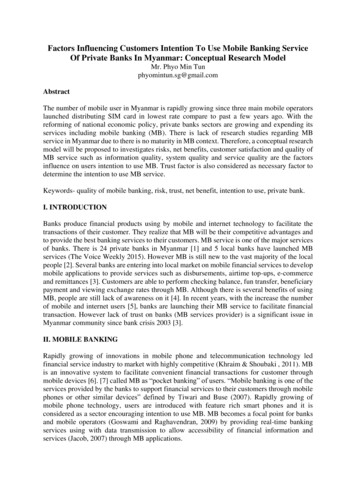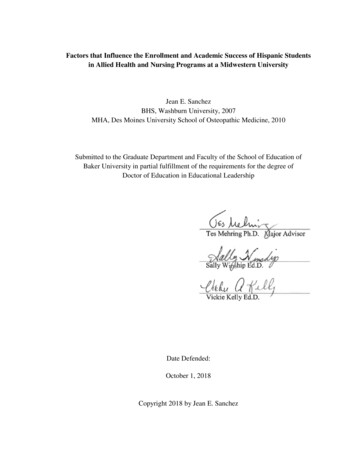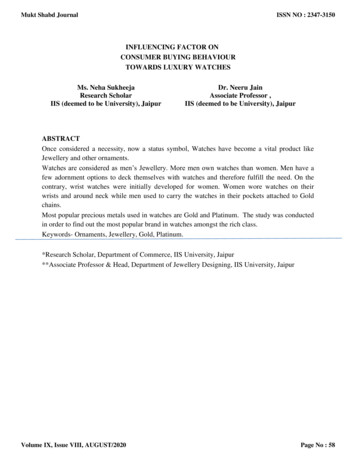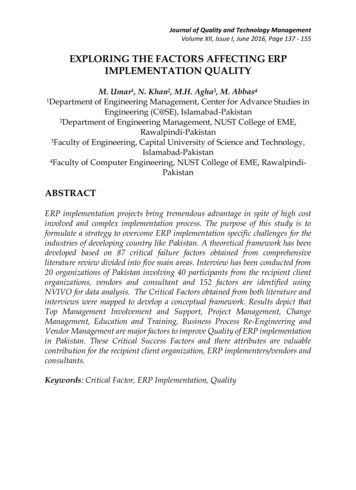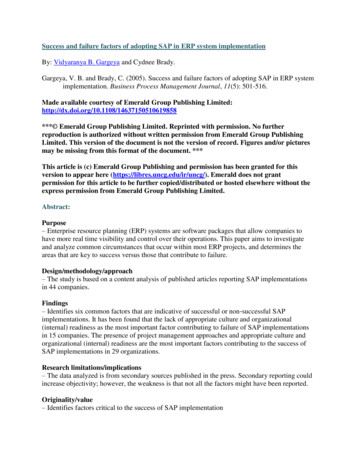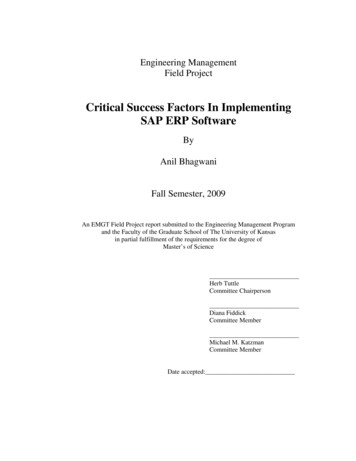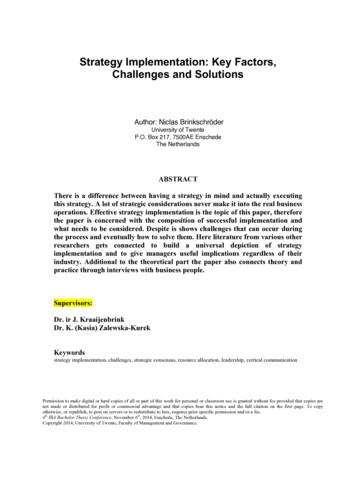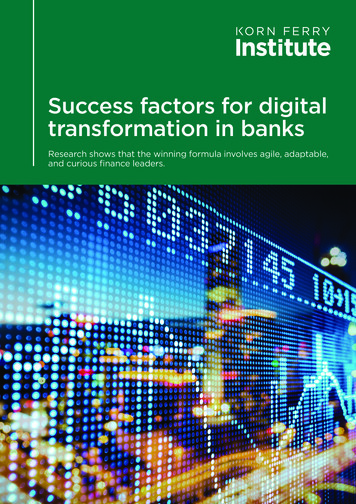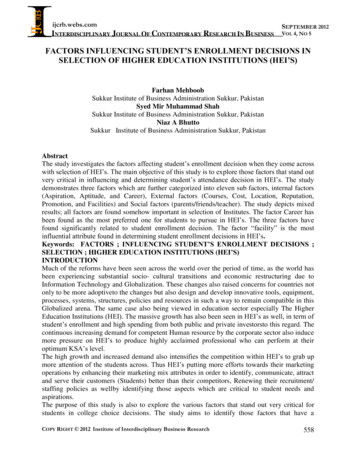
Transcription
ijcrb.webs.comINTERDISCIPLINARY JOURNAL OF CONTEMPORARY RESEARCH IN BUSINESSSEPTEMBER 2012VOL 4, NO 5FACTORS INFLUENCING STUDENT’S ENROLLMENT DECISIONS INSELECTION OF HIGHER EDUCATION INSTITUTIONS (HEI’S)Farhan MehboobSukkur Institute of Business Administration Sukkur, PakistanSyed Mir Muhammad ShahSukkur Institute of Business Administration Sukkur, PakistanNiaz A BhuttoSukkur Institute of Business Administration Sukkur, PakistanAbstractThe study investigates the factors affecting student’s enrollment decision when they come acrosswith selection of HEI’s. The main objective of this study is to explore those factors that stand outvery critical in influencing and determining student’s attendance decision in HEI’s. The studydemonstrates three factors which are further categorized into eleven sub factors, internal factors(Aspiration, Aptitude, and Career), External factors (Courses, Cost, Location, Reputation,Promotion, and Facilities) and Social factors (parents/friends/teacher). The study depicts mixedresults; all factors are found somehow important in selection of Institutes. The factor Career hasbeen found as the most preferred one for students to pursue in HEI’s. The three factors havefound significantly related to student enrollment decision. The factor “facility” is the mostinfluential attribute found in determining student enrollment decisions in HEI’s.Keywords: FACTORS ; INFLUENCING STUDENT’S ENROLLMENT DECISIONS ;SELECTION ; HIGHER EDUCATION INSTITUTIONS (HEI’S)INTRODUCTIONMuch of the reforms have been seen across the world over the period of time, as the world hasbeen experiencing substantial socio- cultural transitions and economic restructuring due toInformation Technology and Globalization. These changes also raised concerns for countries notonly to be more adoptiveto the changes but also design and develop innovative tools, equipment,processes, systems, structures, policies and resources in such a way to remain compatible in thisGlobalized arena. The same case also being viewed in education sector especially The HigherEducation Institutions (HEI). The massive growth has also been seen in HEI’s as well, in term ofstudent’s enrollment and high spending from both public and private investorsto this regard. Thecontinuous increasing demand for competent Human resource by the corporate sector also inducemore pressure on HEI’s to produce highly acclaimed professional who can perform at theiroptimum KSA’s level.The high growth and increased demand also intensifies the competition within HEI’s to grab upmore attention of the students across. Thus HEI’s putting more efforts towards their marketingoperations by enhancing their marketing mix attributes in order to identify, communicate, attractand serve their customers (Students) better than their competitors, Renewing their recruitment/staffing policies as wellby identifying those aspects which are critical to student needs andaspirations.The purpose of this study is also to explore the various factors that stand out very critical forstudents in college choice decisions. The study aims to identify those factors that have aCOPY RIGHT 2012 Institute of Interdisciplinary Business Research558
ijcrb.webs.comINTERDISCIPLINARY JOURNAL OF CONTEMPORARY RESEARCH IN BUSINESSSEPTEMBER 2012VOL 4, NO 5significant influence on student’s enrollment decisions and play a vital role in their decisionmaking process. Many factors have been explored and studied by various researcher across theglobe and investigated its direction and magnitude of relationship with students enrollmentdecisions. They all found various factors, its relationship and relative influence on decisionchoice. The current study also aims to extend the findings of the previous studies and to identifythat which factor influencing more in college attendance choice in Pakistani context.LITERATURE REVIEWMany studies have been done in order to explore the various antecedents and factors which effectthe university or college selection choice decisions among students. Many variables have beenidentified and investigated to determine their impact on the student choice of university orcollege. Chapman (1981) demonstrated the influence of various factors on student collegechoice and reported that personal aspiration, performance at school and external factorscontributes more to college choice (Hossler and Gallagher 1987;Borus 1993). Those externalfactors include marketing efforts by college (Hossler and Bean 1990), characteristics of Institute(Kohn et al, 1976) and significant persons (Baharun et al, 2002). In another study Studenteducational aspirations found positively related with college attendance choice (Carpenter andFleishman 1987; Ariffin et al 2008). The student’s own ability and aptitude also reported as oneof the important contributor in selection of colleges (Manski and Wise 1983; Hossler1984).College location also found to be a significant predictor of College choice as investigated by(Kohn et al 1976; Servier 1986; Servier 1994; Absher and Crawford1996). They noted thatcollege proximity and distance from home could also have a significant impact on student choiceto enroll in college. Academic program offerings, its content range and duration also found tohave a significant association on student’s college selection as reported by (Ford et al, 1999;Yousaf et al, 2008). College Reputation found to be a very strong predictor of College choice asexamined by (Lay and Maguire 1981; Murphy 1981;Keling 2006). They observed that collegereputation has a strong influence and persuasiveness power on student’s college selectiondecisions. Cost associated with college also termed as an important factor to be discussed byvarious researchers (Webb 1993;Joseph and Joseph 1998) as cost has a strong influence incollege choice decisions. Availability of financial aid also has a persuasive power on studentcollege attendance (Litten 1982; Manski 1983; Jackson 1986). They analyzed that financial aidwill likely to induce more enrollments in colleges than other factors.Paulson (1981) examined the impact of Employment opportunity and its relation with collegechoice decisions and found that employment opportunities are the stronger predictor ofenrollment decisions. In another study (Sevier 1998 Garma and Moy 2003) also identified andreported a significant association between employment rate of graduates in determining thecollege attendance decisions. Campus visit also found an important factor in college selectionprocess as noted by (Hossler 1990; Sevier 1992). They concluded that student’s visit to collegealso persuade them to enroll in the college.On the other hand Marketing Mix, Marketing efforts and channels also found to be an importantfactor in influencing student’s college choice. Many researchers study this variable and found it avery significant contributor of enrollment decisions. Felix (2006) while investigating the impactof marketing mix strategies explained that Program and Price attribute of Marketing mix aresignificant determinants of student enrollment choice than other marketing mix variables.Hossler(1990) also examined the influence of advertisement on student college selection andfound that radio and television ads provide a good vehicle for educational marketers toCOPY RIGHT 2012 Institute of Interdisciplinary Business Research559
ijcrb.webs.comINTERDISCIPLINARY JOURNAL OF CONTEMPORARY RESEARCH IN BUSINESSSEPTEMBER 2012VOL 4, NO 5communicate a good image and build strong brand recognition among students in an effectiveway.METHODOLOGYThe study has being done on the first year students of Higher Education institutions (HEI). About251 (n 251) students from HEI’s participated in that study. A self-administrative questionnaire,(Institute selection choice, ISC) was used to collect data from students of various HEI’s. havingcompact description of the purpose of the study that why the study is being conducted for whatthe participants actually have to do with. The ISC questionnaire constitutes 11 factors(Courses/program, Cost/fee structure, Location, Career opportunities, Student AspirationsAptitude/Ability, Friends/Parents Influence, Financial Aid, Institute’s ReputationAdvertisement/Promotion and Facilities/Accommodation) that influence student’s enrollmentdecisions in selection of HEI’s. The factors consist of 40 items with minimum of 3 items each toa single factor as shown(). The response scale ranges from (Not important 1 to Very Important5). There was also Rank Preference Question put into that questionnaire, stating all 11factors.The participants were given a task to rank any three of the most preferred factorsinfluencing their selection decision as 1, 2 and 3 respectively. There was also a portion forDemographic information, with Gender, Age, Program, Semester, Institute, and MonthlyHousehold Income. The participants were given ample time to fill the questionnaire.Before starting conducting surveys, questionnaire was presented to group of experts for havingexpert opinion on the contents, items, scale and factor description etc. After having someamendments, it was finally put into survey process. A pilot study was also being done on 15students in order to check the content or face validity and reliability of the questionnaire as well.The test gave reasonable results towards validity and reliability thus making it feasible for datacollection. The reliability coefficient, Cronbach’s alpha of 44 items was found to be .92 whichshows a highly reliable and consistent measuring tool. According to Nunnally (1978) thereliability coefficient of .70 is acceptable one for internal consistency of the measure.DATA ANALYSISThe various statistical techniques have been applied to accomplish the objectives of the study.Descriptive stats, Mean, Standard Deviation, has done to check the level of importance of eachfactor and across demographics i.e Gender, Age, Household income etc. as well, the standarddeviation to know the variance of the data from its mean value. For ordinal values descriptivestats has also been done to check the frequency and preferences of the factor orders. The interitem correlation has also been done to test the multi - co linearity among predicting variableswith each other. The coefficient of correlation (Pearson r) also done to test the direction andmagnitude of relationship among enrollment decision factors with institute selection decisions.Multiple regression analysis has also been done to check out the relative influence of predictingvariables in determining student’s enrollment decisions.RESULTS/FINDINGSThe Descriptive stats have been done to know the relative frequency and proportionatedistribution among demographic variables table 1. It also shows the mean value of the factorsand their contributions to the enrollment decisions among students table 1. In Gender, malestudents took part more in the study with valid percentage case of 73.1 % than female students,who’s valid percentage was 26.9% of the total participation. In Age group, the participants withCOPY RIGHT 2012 Institute of Interdisciplinary Business Research560
ijcrb.webs.comSEPTEMBER 2012INTERDISCIPLINARY JOURNAL OF CONTEMPORARY RESEARCH IN BUSINESSVOL 4, NO 5age under 20 have contributed more in the study with valid percentage of 53.3%. As only thefirst year students of HEI actually the target population of the study therefore the studentsstudying in first and second Semester were targeted to accomplish this study. The studentsstudying in second semester participated more in the study with valid percentage of 54.3% thanthe first semester students. Other variable like House hold income were also added in thedemographic contents, in order to know the Household income level of the students and itsrelative influence in determining student’s enrollment decision, that is analyzed in RegressionAnalysis. The Students having household income less than 25000 PKR were found more thanother income group individuals with valid percentage of 47.2%. Table 1 also shows the meanvalues of the enrollment decisions with each of the demographic variable.Table 1: Frequency Distribution and Mean values of the DemographicsFrequencyGenderMaleFemaleAgeUnder 20Above 20Semester1st2ndHouse hold Income PKR/MonthlyLess than 2500025001-5000050001-7500075001-100000More than 100000Valid PercentageMean Enrollment 13.813.823.743.243.91Table 2 shows the Mean value of the factors contributing to enrollment decision in HEI’s. It alsoshows the number of items, a factor possesses in the study and the values of the measure ofCronbach’s alpha for each of the factors to know their reliability and internal consistency. Thefactor “Aspiration” has found to be the most important attribute and contributing more in theenrollment decisions made by the students in selection of HEI’s with mean value of 4.12. While“cost” found to be the least important factors in contributing to student’s enrollment decisions.Table 2 also shows the Cronbach’s alpha of factor each, Reliability Coefficient of all factorsfound reasonable except the two factors Courses/Program and Location, whose Cronbach’sAlpha was touch on the lower side with alpha (.524 and .481) respectively. The factors “Careeropportunities” and “Facilities/Accommodation” shows a strong reliability and internalconsistency with alpha (.847 and .831) respectively.COPY RIGHT 2012 Institute of Interdisciplinary Business Research561
ijcrb.webs.comSEPTEMBER 2012VOL 4, NO 5INTERDISCIPLINARY JOURNAL OF CONTEMPORARY RESEARCH IN BUSINESSTable 2: Mean values, Number of items and Cronbach’s alpha of each 24Cost/Fee 11Friends/Parents Influence3.4130.662Financial Aid3.8530.723Institute's 792Facilities/Accommodation3.8250.831Table 3 shows the rank preference of each factor, the students rank each of the factors accordingto their utmost preferences. There was also a preference rank question in the questionnaire inwhich students were asked to rank any three most preferred factors that stimulates theirenrollment decision in HEI’s. The table shows the students rank distribution to each factor. Thefactor “Career opportunities” was regarded as the most preferred factor among the students thatinduce their enrollment decision. The “Courses/ Program” was the second most preferred factorrespectively. It means that student prefer their career as the one which motivates them to takeRankFirst 1Second 2Third 3C/P 41181216141516172021122573713admission in HEI’s.Table 3: Rank orders of the FactorsC/P (Courses/Program), C (Cost), L (Location), CO (Career Opportunities), A (Aspiration), A/A (Aptitude/Abilities), F/P/T(Friends/Parents/Teacher), FA (Financial Aid), IR (Institute’s Reputation), A/P (Advertisement/Accommodation), F/AFacilities/Accommodation.Table 4 shows the inter-item correlation matrix among predicting variables in order to analyzethe magnitude and direction of the relationship with each other. The main objective of thistechnique is to check the multi co-linearity among predicting variables with each other. The VIF(Variance Inflation Factor) a multi co-linearity detector tool was used to identify the multi colinearity among predicting variables because high multi co linearity could distort the values ofstandard error thus affecting the t values. So there are possibilities to commit Type I or Type IIerror. To avoid those possibilities of multi co linearity the VIF has being done in this study. TheCOPY RIGHT 2012 Institute of Interdisciplinary Business Research562
ijcrb.webs.comSEPTEMBER 2012INTERDISCIPLINARY JOURNAL OF CONTEMPORARY RESEARCH IN BUSINESSVOL 4, NO 5values of VIF of all predicting variables fall between 1and 3 thus showing that multi co linearityamong variables is acceptable. Although the relationship between predicting variable with eachother is significantly positive but the multi co linearity is reasonably 411**.331**.242**.423**.549**.572**111Table 4: Inter-factor Correlation Matrix*. Correlation is significant at the 0.05 level (2-tailed).**. Correlation is significant at the 0.01 level (2-tailed).Table 5 shows the Multiple Regression Analysis results in which all 11 factors were regressedwith the dependent variable of student decisions. The MRA has been done in order to check therelative influence and predicting power of the predicting variables in predicting student’senrollment decision. That test actually based on the objectives of our study, to know theinfluence of the factors which actually determines the enrollment decisions. The MRA showsthat three factors Facilities, Financial Aid and Parents/friends, found significantly influential inpredicting student enrollment decision in HEI’s. The factor Facilities/Accommodation has foundto be the most influential factor (b .362, P .01) in determining student enrollment decision,followed by “financial aid and Parents/friends” with (b .138, P .05 and b .134, P .05)respectively.The factor “Facilities” contains five of the mentioned items. The Quality instructional aids,Reasonable Hostel accommodation, Library facilities with adequate study materials andresources, Transport facilities and Computer lab facilities provided by the Institute. The MRAdepicts that Facilities provided by the institute have the greater impact when the student want tobe in the institute and could be the decisive factor in their selection decisions. So the instituteCOPY RIGHT 2012 Institute of Interdisciplinary Business Research563
ijcrb.webs.comSEPTEMBER 2012INTERDISCIPLINARY JOURNAL OF CONTEMPORARY RESEARCH IN BUSINESSVOL 4, NO 5should take more care about their facilities and services infrastructure to flourish and long runprospects.On the other hand Zero order correlation has also been done in order to know the magnitude anddirection of the relationship among independent variables and the enrollment decision. Allfactors found positively related to student enrollment decision but the magnitude of therelationship was weak to moderate one. The Facilities shows a strong correlation (r .553, P .01) with student enrollment decision while the factor Cost shows a weak association (r .168)with enrollment decision.The R- square shows the goodness of fit that how our model integrates with estimations andpredictions we made. It also shows that how much the variance has been explained by predictingvariables in the dependent variable. The R- square was found to be a reasonable one of .372,which suggests that 37.2% of the variance has been explained by the independent variables independent variable. The F test (ANOVA) shows a significant difference (F 10.224, P .01)between independent variables and dependent variable.Table 5: Multiple Regression Analysis (MRA) and Zero Order Correlation on.066.798.426.399Financial R SquareF.135.37210.224*a. Dependent Variable: Student Decision*P .01, **P .05COPY RIGHT
the university or college selection choice decisions among students. Many variables have been identified and investigated to determine their impact on the student choice of university or college. Chapman (1981) demonstrated the influence of various factors on student college choice and reported that personal aspiration, performance at school .File Size: 483KB

